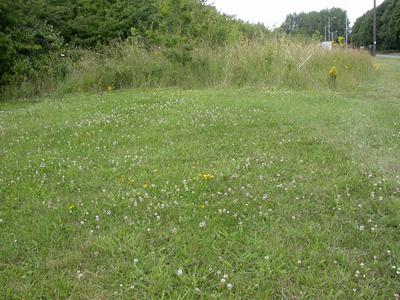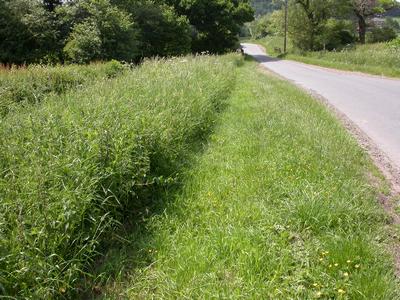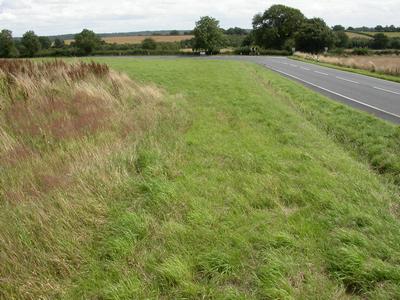INVERTEBRATES AND ROAD VERGE MANAGEMENT
An investigation into the effects of road verge management on invertebrate populations. An attempt is made to gauge the quantity and variety of species under different treatments.
Methodology
The suction sampler is a petrol-driven garden blower and vacuum (Stihl SH56C), modified by the addition of a collecting bag (Vac-Bag from B & S Entomological Services) at the far end of the suction tube.
In an attempt to standardise the collection, the machine is walked along a 10m line, dabbing the end on the ground in overlapping places so that collecting takes place over the width of the suction nozzle (145 mm, and perhaps rather more due to the suction), and a length of 10m. This is quite easy to do when the grass is short, but it becomes more difficult to maintain a straight line in thicker, longer grass or through nettle or thistle beds. In these situations I endeavoured to try to keep the area covered the same. The drawing of mowings into the tube may have some effect on the suction further along the line, but a large free area of bag still remains for the air to pass through.
The contents of the collecting bag are transferred to a labelled, sealable polythene bag. Observation showed that there is little loss of material on transfer.
Comparisons are aimed to be as fair as possible by using short and long vegetation in the same location, at the same time, with the same orientation to the sun, and ‘edge’ effects are reduced by looking for larger areas of both long and short vegetation, and by working in the middle of these areas.
The bags are put into a freezer at –18 C for at least three hours to kill the invertebrates before sifting to collect the material for identification. It is surprising that there was often one weevil that would survive this process.
 |
Winyates road verge |
| Woodgate road verge |  |
 |
Inkberrow road verge, after the outer area had been cut |
Sites and Results:
The results in the tables show the number of each group collected, followed by the number of species identified in brackets. Many immature specimens could not be identified.
Two sites were visited more than once:
Near Inkberrow there is a sharp bend (SP009562) where the fence line has been taken well back to give better visibility, and mowing has produced three distinct areas. There is a picnic area with benches where the grass is kept very short, an outer area on the bend, which is mown infrequently possibly for hay, and an inner area that is cut annually, if at all.
On my first visit there on 24th June 2009, I was amazed that the shortest area yielded nothing, not even a springtail or a money spider.
|
The outer area, which was long grass with knapweed |
The inner area mostly docks with bare ground under |
Closely mown area |
|
|
Spiders |
18 (7) |
1 (1) |
0 (0) |
|
Flies |
2 (not examined) |
0 |
0 |
|
Beetles |
11 (5) |
5 (4) |
0 (0) |
|
Bugs |
6 (3) |
2 (3) |
0 (0) |
On a further visit on 28th July 2009, the outer area had been mown and showed some re-growth. The majority of the mowings appeared to have been removed.
|
The outer area, re-growth |
The inner area mostly docks with bare ground under |
|
|
Spiders |
3 (3) |
55, mostly immature (5) |
|
Flies |
1 (not examined) |
9 (not examined) |
|
Beetles |
2 (2) |
9 (5) |
|
Bugs |
2 (1) |
18 (9) |
|
Springtails |
0 (not examined) |
38 (not examined) |
|
Harvestmen |
0 (0) |
7 (2) |
There are a number of factors involved here, including the time of year, and possible migration from one area to another.
In Winyates, Redditch, (SP072668) a wide road verge where one area is mown frequently, and other areas less frequently or not at all – seemingly at the whim of the mower operator.
On 10th July 2009
|
Short grass |
Longer vegetation |
|
|
Spiders |
4 (2) |
4 immature |
|
Harvestman |
0 (0) |
1 immature |
|
Beetles |
3 (2) |
12 (7) |
|
Bugs |
(0) |
9 (4) |
|
Snails |
0 |
5 (not examined) |
|
Woodlice |
0 (0) |
14 (1) |
On 7th September 2009
|
Short grass, regrowth |
Longer vegetation |
|
|
Spiders |
53, including 25 immature (10) |
63, including 33 immature (7) |
|
Caterpillars |
3 (not examined) |
1 (not examined) |
|
Beetles |
16 (9) |
48 (14) |
|
Bugs |
2 (1) |
3 (1) |
|
Snails |
5 (not examined) |
0 |
|
Woodlice |
0 (0) |
6 (1) |
|
Millipedes |
0 (0) |
3 juvenile |
A number of other sites were visited once:
Near Hanbury Fish Ponds (SO967 642), a narrow verge, and therefore subject to more edge effects. 5th June 2009
|
Short grass |
Longer vegetation |
|
|
Spiders |
3 (2) |
7 (2) |
|
Flies |
3 (not examined) |
27 (not examined) |
|
Beetles |
5 (2) |
4 (4) |
|
Bugs |
3 (2) |
|
|
Moth |
0 (0) |
1 (0) |
Woodgate (SO972666) 5th June 2009
|
Shorter grass |
Longer grass, nettles, thistles |
|
|
Spiders |
4 (4) |
11 (7) |
|
Beetles |
2 (2) |
2 (2) |
|
Bugs |
6 (1) |
2 (1) |
|
Snails |
1 (not examined) |
10 (not examined) |
|
Woodlice |
0 (0) |
1 (1) |
Near Elcocks Brook (SP010641), 24th June 2009
|
Shorter grass |
Longer vegetation |
|
|
Spiders |
8 (5) |
7 (5) |
|
Harvestmen |
1 (1) |
4 immature |
|
Beetles |
7 (5) |
0 (0) |
|
Bugs |
13 (4) |
3 immature |
|
Snails |
0 |
0 |
|
Woodlice |
0 |
1 |
|
Flies |
3 (not examined) |
11 (not examined) |
Near Goosehill Wood (SO938603) 1st July 2009
|
Shorter grass, regrowth |
Longer vegetation |
|
|
Spiders |
15 (7) |
6 (5) |
|
Harvestmen |
0 |
5 (3) |
|
Beetles |
19 (10) |
6 (5) |
|
Bugs |
7 (4) |
6 (4) |
|
Woodlice |
3 (1) |
0 (0) |
|
Flies |
1 (not examined) |
3 (not examined) |
Near Hanbury (SO958625) 2nd July 2009
|
Shorter grass, mown about 1 week |
Longer vegetation, mown last year |
|
|
Spiders |
6 (6) |
6 (6) |
|
Harvestmen |
0 (0) |
2 (2) |
|
Beetles |
3 (3) |
8 (5) |
|
Bugs |
0 (0) |
10 (4) |
|
Snails |
0 |
0 |
|
Woodlice |
0 |
0 |
|
Flies |
0 |
5 (not examined) |
Near Flyford (SO991550) 28th July 2009
|
Shorter grass |
Longer vegetation |
|
|
Spiders |
14 (9) |
27 (6) |
|
Harvestmen |
0 (0) |
11 (2) |
|
Beetles |
6 (4) |
44 (10) |
|
Bugs |
9 (2) |
20 (4) |
|
Snails |
0 |
4 (not examined) |
Conclusions:
Even based on numbers of individuals in each group without looking at species lists, it is evident that the variety and numbers differ considerably from place to place and during the season.
The first Inkberrow results suggest that the ‘neglected’ area was not as good as the area that had been managed, possibly due to its open structure, but by the time the outer area had been mown and had regrown somewhat, the ‘neglected’ area was superior.
On other sites, the managed growth had the greater numbers of invertebrates, suggesting that complete ‘neglect’ is not the answer, but over-management, producing very short grass, will give low invertebrate numbers.
It would be useful to find some measure of grass length, vegetation density and plant species diversity to correlate with the organism count, although I admit that I do not really see how this can be done, and also to know the management regime of each site.
The variations make it impossible to devise a mowing regime that will definitely encourage invertebrates in road verges, because different species have different requirements, and the requirements may well vary according to weather conditions and season.
It looks as if some management is desirable, otherwise a monoculture of nettles, or docks, or brambles could result, but all of these species have their conservation value. I also accept that it is necessary to mow verges for safety reasons, but need there be so much mown so short? Sight lines do not require very short grass, so perhaps we need some evidence as to whether cutting grass long, rather than short, would require more frequent mowing.
Further work:
2009 has been a very poor year for most invertebrates, and there is a need to do more work in what could be a more normal year, to see if the differences increase or decrease. I would also hope that this might inspire people with different expertise to have a look at this important habitat, but do bear in mind the Health & Safety aspect. I have tried to visit quiet roads or roads with wide verges, and hoped that no drivers would be distracted.
None of the above work gives any idea of the usefulness of longer vegetation during the winter. All of our resident invertebrate species have to survive the winter in some form, whether it be as eggs, larvae or adults, and the evidence from tussocking suggests that thicker grass supports a wider community – not a surprising result. We know that non-tussock grass supports a lower density of species during the winter, but this could well be outweighed by the greater area involved.
I would expect this work to suggest that there is a need to leave some areas un-mown during the winter, probably on a rotation basis to prevent eventual scrubbing up.
I would be very pleased if anyone could indicate any work that could be done to show the value of verges as wildlife corridors, which may become even more necessary as climate change drives migration.
I am indebted to Steven Bloomfield, Gary Farmer and Ann Hill for being kind enough to read through the earlier draft, and for their valuable comments. Any blame for inaccuracies remains with me.